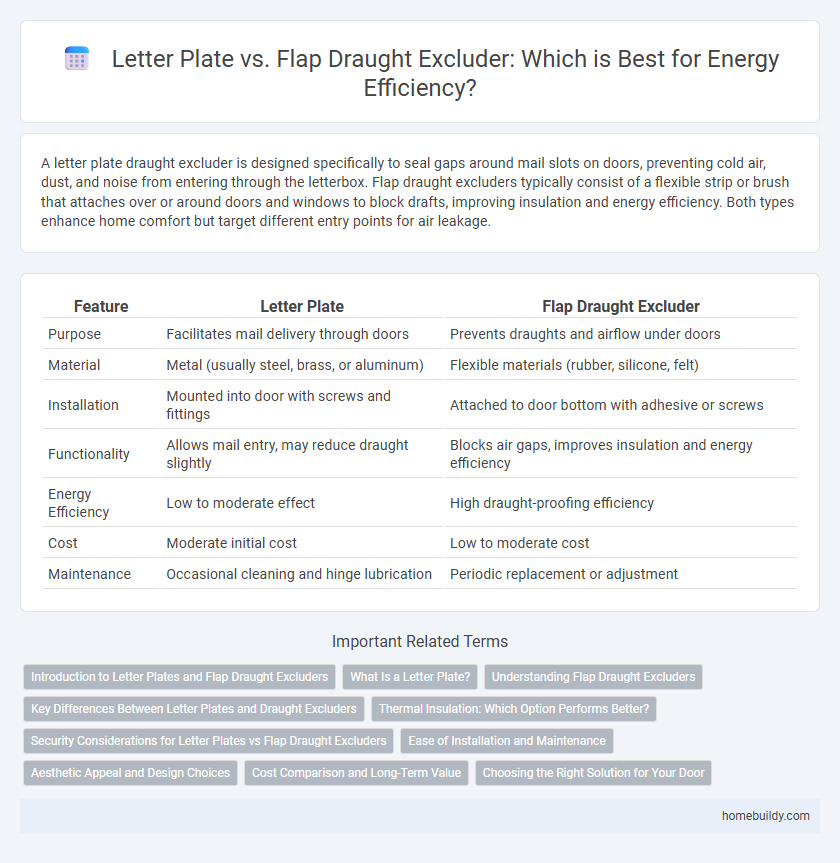A letter plate draught excluder is designed specifically to seal gaps around mail slots on doors, preventing cold air, dust, and noise from entering through the letterbox. Flap draught excluders typically consist of a flexible strip or brush that attaches over or around doors and windows to block drafts, improving insulation and energy efficiency. Both types enhance home comfort but target different entry points for air leakage.
Table of Comparison
| Feature | Letter Plate | Flap Draught Excluder |
|---|---|---|
| Purpose | Facilitates mail delivery through doors | Prevents draughts and airflow under doors |
| Material | Metal (usually steel, brass, or aluminum) | Flexible materials (rubber, silicone, felt) |
| Installation | Mounted into door with screws and fittings | Attached to door bottom with adhesive or screws |
| Functionality | Allows mail entry, may reduce draught slightly | Blocks air gaps, improves insulation and energy efficiency |
| Energy Efficiency | Low to moderate effect | High draught-proofing efficiency |
| Cost | Moderate initial cost | Low to moderate cost |
| Maintenance | Occasional cleaning and hinge lubrication | Periodic replacement or adjustment |
Introduction to Letter Plates and Flap Draught Excluders
Letter plates and flap draught excluders serve distinct purposes in home insulation and security; letter plates provide a secure opening for mail delivery, while flap draught excluders help seal gaps to prevent heat loss and drafts. Modern letter plates often feature integrated draught proofing mechanisms to combine functionality and energy efficiency, reducing unwanted airflow through the mail slot. Choosing a high-quality flap draught excluder or a letter plate with an effective seal enhances thermal insulation, contributing to lower energy bills and improved indoor comfort.
What Is a Letter Plate?
A letter plate is a metal or plastic cover fitted over the mail slot on a door, designed to provide security while allowing mail to be delivered. Unlike flap draught excluders, which primarily prevent air leaks around doors or windows, letter plates focus on protecting against weather, noise, and intruders. These plates often include insulated flaps or brushes to reduce draughts and improve energy efficiency without compromising mail access.
Understanding Flap Draught Excluders
Flap draught excluders are designed to fit tightly around letter plates, creating an effective barrier against cold air, dust, and noise while allowing mail to pass through. Unlike traditional letter plates, flap draught excluders use flexible rubber or brush seals to reduce energy loss by minimizing gaps around the door. Understanding flap draught excluders involves recognizing their role in enhancing thermal insulation and improving overall home comfort compared to basic letter plate designs.
Key Differences Between Letter Plates and Draught Excluders
Letter plates are designed to allow mail delivery through a door while providing basic weather protection, whereas flap draught excluders focus primarily on minimizing air leaks and improving insulation around doors. Letter plates feature a hinged flap that may reduce heat loss but are less effective at blocking drafts compared to draught excluders, which use flexible or brush seals to create airtight barriers. The key difference lies in their primary function: letter plates facilitate postal access, while draught excluders enhance energy efficiency by sealing gaps.
Thermal Insulation: Which Option Performs Better?
A letter plate with built-in thermal insulation typically outperforms flap draught excluders by minimizing heat loss through the door more effectively. Letter plates with insulated liners or magnetic seals create a tighter barrier against cold air infiltration while maintaining security and convenience. Flap draught excluders primarily reduce drafts but provide less comprehensive thermal protection compared to the specialized materials used in insulated letter plates.
Security Considerations for Letter Plates vs Flap Draught Excluders
Letter plates present potential security vulnerabilities as they provide a direct access point through which intruders can manipulate locks or reach inside the property. Flap draught excluders enhance security by covering gaps without creating openings, significantly reducing the risk of tampering while maintaining insulation. Choosing flap draught excluders over letter plates can improve home security by minimizing entry points exploited by burglars.
Ease of Installation and Maintenance
Letter plates offer straightforward installation by simply fitting into door cutouts, requiring minimal tools and time compared to flap draught excluders that often need adhesive application or screw fixing. Maintenance of letter plates is easy, involving occasional cleaning of the metal or plastic surface, whereas flap draught excluders may need regular adjustment or replacement of flexible seals due to wear and tear. The rigid structure of letter plates generally provides longer-lasting durability with less frequent upkeep than the softer, more vulnerable materials used in flap draught excluders.
Aesthetic Appeal and Design Choices
Letter plates offer a sleek, minimalist aesthetic that seamlessly integrates into door designs, enhancing curb appeal without disrupting the exterior's visual harmony. Flap draught excluders tend to be more functional but can appear bulky or intrusive, which may detract from a door's clean lines and overall style. Choosing between a letter plate and flap draught excluder depends on balancing aesthetic preferences with practical requirements, emphasizing design cohesion and subtlety in home exteriors.
Cost Comparison and Long-Term Value
Letter plates generally cost less upfront compared to flap draught excluders, making them a more budget-friendly choice for immediate installation. Flap draught excluders, though initially pricier, offer superior insulation and durability that can lead to significant energy savings over time. Investing in a quality flap draught excluder often results in better long-term value through reduced heating bills and enhanced home comfort.
Choosing the Right Solution for Your Door
Letter plates provide a traditional way to receive mail while maintaining door aesthetics, but they can allow drafts and heat loss. Flap draught excluders are designed to seal gaps around the letter plate, reducing airflow and improving energy efficiency. Selecting the right solution depends on balancing insulation needs with ease of mail delivery and door design compatibility.
Letter plate vs flap draught excluder Infographic

 homebuildy.com
homebuildy.com